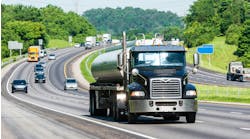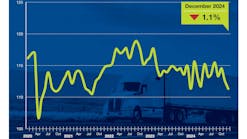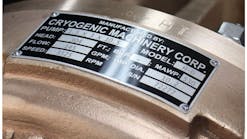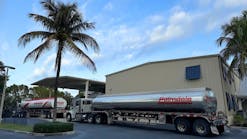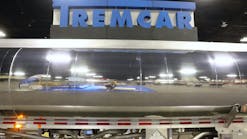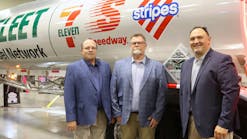Natural gas gaining traction as fuel for milk, other food haulers
ON A PLEASANT August morning, I'm behind the wheel of a bright red Kenworth T440 tandem-axle tractor rounding the test track at the Paccar Technical Center in Mount Vernon, Washington. It is one of several natural gas-fueled tractors I drove at the test track that day.
What makes this T440 notable is that it runs on compressed natural gas and bears somewhat of a resemblance to the new CNG-fueled T440s that just went into milk hauling service at Fair Oaks Farms (the cover story in this issue of Bulk Transporter).
While certainly not a truck driver, I can say that the CNG-fueled T440 seems to have plenty of power and runs much quieter than many of the trucks I've ridden in over the years. This T440 was configured for medium-duty applications with a gross combination weight well under 80,000-pounds, but the truck and itsnine-liter Cummins ISL G engine can be uprated for Class 8 service at 80,000 pounds. Tractor specs included two CNG fuel tanks and an Allison six-speed automatic transmission.
The reason for the test track drive was a Kenworth Truck Co press event for trucking publications that gave representatives from Kenworth and Westport Power Inc an opportunity to show off the latest in natural gas engines offered with Kenworth trucks and discuss the benefits of natural gas as a fuel for tank truck fleets and other trucking companies.
Big future
Kenworth currently offers several natural gas-fueled truck models. Editors had the opportunity to test drive a T800 daycab tandem-axle tractor with a 485-horsepower Westport HD GX15 (based on Cummins' 15-liter ISX) engine fueled by liquefied natural gas (LNG) and tandem- and single-axle versions of the T440 with the 320-hp Cummins Westport ISL G running on CNG.
“We believe there is a big future for heavy-duty trucks fueled with natural gas,” said Andy Douglas, Kenworth national sales manager, specialty markets. “Customers are asking for these products, which use existing diesel technology that is robust, tough, and proven.
“Here in the United States, we sit on the world's largest natural gas reserves. Other countries are using it more in transportation than we are. Oil will continue to face price pressures, while natural gas prices have remained relatively constant.”
About 23,000 vehicles in the United States are fueled by natural gas at this time. That includes approximately 800 tractors that have gone into port drayage operations in California and other states as part of emission-reduction campaigns. In addition to the Fair Oaks Farms project, a number of tank truck fleets have purchased natural gas fueled trucks over the past couple of years. The largest tank fleet order to date was for 200 tractors that will be used in oilfield operations.
Hefty investment
Kelly Mills, Westport HD's Western US sales manager, pointed out that Westport has invested more than $250 million in natural gas fuel systems and has deployed more than 28,000 natural gas engines worldwide. “We see plenty of opportunity for this technology with US truck fleets,” he said.
More than 10,000 of the company's nine-liter Cummins Westport ISL G engines have been produced. While nominally classified for medium-duty applications hauling less than 80,000 pounds gross combination weight, the engine is offered with a severe-duty exemption for certain local and regional bulk transport applications.
“This engine will handle 80,000 pounds under the right applications,” Mills said. “The operating area needs to be primarily flat terrain, because the engine isn't available with an engine brake.”
Rated at 250 hp to 320 hp, the Cummins Westport ISL G can be fueled with either CNG or LNG. It is a spark-ignition engine that doesn't need selective catalytic reduction (SCR) emission treatment technology or a diesel particulate filter (DPF).
Longhaul power
The 15-liter Westport HD is available with engine ratings from 400 hp to 475 hp and is designed to use LNG and run in longhaul applications. With gross combination weight ratings of 80,000 pounds to 140,000 pounds, this is the ideal natural gas engine for longhaul tank fleets, according to Mills.
The Westport HD engine differs from the Cummins Westport ISL G in several ways. Most importantly, the Westport HD uses a fuel mix that includes about 5% diesel. This means the engine must have the SCR treatment system and the DPF required for fully diesel-fueled engines.
Built with Westport's high-pressure direct-injection (HPDI) technology, the GX engine uses natural gas as the primary fuel, along with a small amount of diesel as a pilot ignition source or “liquid spark plug.” At the heart of the system is a patented injector with a dual-concentric needle design. It allows small quantities of diesel and large amounts of natural gas to be delivered at high pressure to the combustion chamber.
Under the pressures found in the combustion chamber of a typical diesel engine, natural gas requires a higher ignition temperature than diesel. The diesel is injected into the cylinder first and acts as a pilot, rapidly igniting the hot combustion products, including the natural gas.
The Cummins Westport ISL G and Westport HD GX engines offer up to 20% reduction in greenhouse gas emissions. In addition, the ISL G achieves an 80% NOx reduction, while the GX cuts NOx by nearly 90%, compared to trucks with pre-2010 engines. ♦

